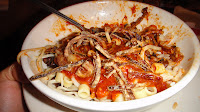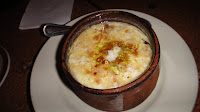But I am also au gourmand; I wander from country to country in search of the very best food on offer. As often as I ask for directions, I ask for restaurant recommendations. I am a pilgrim, subscribing to the Epicurean faith and bound forever by my inexorable love for food; food is sacred and partaking a meal is a celebration.
Yet, while I was in Egypt, I subsisted primarily on kushari – a textually interesting mixture of chopped vermicelli, macaroni and rice with black lentils, topped by a potent tomato sauce and aromatic fried shallots – and om-ali – a porridge like dessert of phyllo pastry, milk, raisin and nuts. During the twelve-day journey from Cairo to Luxor, I must have eaten a minimum of twelve kushari and fifteen om-ali, the latter I would often have one in the afternoon and save the other for breakfast because, after all, it was very similar to porridge. My diet, otherwise, was interspersed with greasy falafels and burned fowls, introduced by local Egyptian friends, helpful and friendly but lacking any gustatory sensitivity. I deeply missed the green colors in my dishes.
Years have gone by since my trip to Egypt. I may have been a bigot and still may be one, but my insatiable appetite forces me to remain open-minded. There is still no Egyptian category on Yelp and I have not had any Egyptian food since my failed attempt to recreate kushari in my kitchen. Now, here was my chance of re-visiting Egyptian cuisine through the laudable and brilliant Ambassador Program with my own personal food ambassador; it is a miniature trip, but without the plane delays, lost luggage and language deficiency.
Appetizers
 |
| Salatah |
 Suddenly, a bright yellow sphere grabbed my attention, and I quickly reached over with my fork before anyone had discovered this yellow gem. Amidst the drones of lively conversations, I fought with the yellow orb – the smooth leathery surface nimbly and obstinately fended off my attack – with a polite half-smile plastered over my face and beads of sweat forming on my brows. Finally, I gave in and picked up the obnoxious object with my fingers, protected by a pair of old gloves in the subway car – to claim possession. Then, I asked for guidance from the obliging assistant ambassador (nominated by me in camera): What is this? It was a lime pickle. The skin of the lime was indeed leathery even against the bite of my teeth; not so sour but astringent and bitter, it might have been a necessary respite for the latter meat courses, but overwhelming by itself. I watched the yellow ball, irregular now, ferried away with the dirty plates, not without a sign of relief.
Suddenly, a bright yellow sphere grabbed my attention, and I quickly reached over with my fork before anyone had discovered this yellow gem. Amidst the drones of lively conversations, I fought with the yellow orb – the smooth leathery surface nimbly and obstinately fended off my attack – with a polite half-smile plastered over my face and beads of sweat forming on my brows. Finally, I gave in and picked up the obnoxious object with my fingers, protected by a pair of old gloves in the subway car – to claim possession. Then, I asked for guidance from the obliging assistant ambassador (nominated by me in camera): What is this? It was a lime pickle. The skin of the lime was indeed leathery even against the bite of my teeth; not so sour but astringent and bitter, it might have been a necessary respite for the latter meat courses, but overwhelming by itself. I watched the yellow ball, irregular now, ferried away with the dirty plates, not without a sign of relief. Vegetables
Upon receiving the Ambassador Dinner invitation to Cherry Café, I was immediately intrigued by the following comment from the Egyptian ambassador: “There will be a variety of vegetable dishes (the primary part of an Egyptian diet)…” (emphasis added). I read Cherry Café’s menu from front to back and back to front, where were the vegetables? All I had found in the menu had already appeared on the table – the adequate but unexciting Mediterranean / Middle-Eastern staples. Was it a diplomatic trick? Yes, it was, but not to get us here to the restaurant: The trick was to ask for the special vegetables of the day, like a secret handshake. It was not a wonder then that I missed out on the vegetables in Egypt.
 |
| Kolka |
 |
| Bema |
The first vegetable dishes were bitingan (eggplants) with green peppers and garlic and moussaka (eggplant in tomato sauce). However, I was becoming impatient for real surprises, promised by the ambassador. Soon enough, I got what I wanted – all four of them: Kolkas (taro) cooked in chard; batatis (potatoes) in tomato sauce; bema (okra) in tomato sauce; and basila (green peas) in, what else, tomato sauce. The most interesting dish was, no doubt, the kolkas – diced taro cooked in a macerated chard soup. The slightly herbal tone of the chard added an unexpected delicacy to the familiar taro, and if I had not minded my manners in honor of the occasion, I would have set the dish directly in front of me, instead of politely and surreptitiously sneaking spoonful after spoonful, dripping green bits of chard in the wake. As hindsight, bigger chunks of taro in the kolkas would have been desirable; the dissolving purple cubes reminded of soup kitchen. The other three dishes were all done in tomato sauce; the acidity of the fresh tomato unexpectedly managed to complement each ingredient individually: The potatoes were soft and fluffy, while the peas popped joyfully on the palate. The endearingly small baby okras, meltingly soft and slightly sticky, were only as big as half of my thumb.
 |
| Basila |
 |
| Kofta |
Then, two whole browned stuffed pigeons flew in to save the Egyptian meat dishes from utter failure to much happy exclamation (and semi-exasperation because, by the time of their grand arrival, the table was overflowing). Cutting the birds in halves revealed the stuffed rice hidden inside: The rice, rich after having soaked up all the fat and juice of the pigeons, was the real joy of the dish, although the dark flesh was nicely rubbed with spice and roasted until finger-tearing tenderness.
 |
| Stuffed Pigeon |
 |
| Macorona béchamel |
Pasta; Rice
 |
| Kushari |
After much neck twisting toward the direction of the kitchen, kushari was brought to our table by the over-worked waiter. Yes, yes, yes, it was almost as good as what I had at a famous kushari restaurant in Cairo; and, of course remembrance is always slightly superior to the reality, no? Cherry Café’s tomato sauce had the right amount of tang in the tomato sauce, which was critical to kushari. A shot of vinegar is the key, the assistant ambassador whispered to me. I see. The crispy fried shallots, the broken pasta, the grainy lentils combined to produce an agreeable medley of textures. Kushari, now that I come to think of it, must have been born out of age-old wisdom of people in the desert: The acidity of the tomato stimulates appetite under the scorching sun; the varied texture keeps it interesting so that one can consume a large bowl; and the starch is quite filling, whether touring or quarrying for the pyramids.
 |
| Konafa |
 |
| Om-ali |
Beverages
 |
| Karkadeh |
Limeade arrived after the meal and before the desserts. It was a thick, opaque and syrupy drink; its heaviness relieved by the tanginess of fresh lime. In the arid desert heat, a pint of San Pellegrino mixed with the limeade syrup would make an excellent cooler, and that was precisely what I needed to neutralize the abundance of sugar in this drink.
 |
| Sahlab |
A strong mint tea concluded our culturally fascinating meal, and to make way for, the shisha, a.k.a, hookah.
***Many thanks to Jeff for creating the wonderful Ambassador Program; Sally for being a cheerful and engaging host; and Nora for solicitously answering all of my questions.***
Cherry CaféAddress: 34-02 Broadway, Astoria, NY 11106
Phone: (718) 274-6000


i didn't see many of the items you talked about on their menu posted online. like for the vegetables, do you just have to ask and see what they have? i'm dying to get authentic egyptian food in new york.
ReplyDeleteMany apologies for missing your posting. No, the vegetable items are no on the menu. You have to ask the lady what they have on that day. I was told that there would always be some vegetarian specials. Enjoy.
ReplyDelete